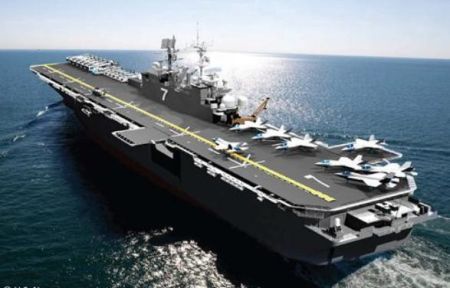
GE’s Power Conversion business has signed a contract worth more than $10 million with Huntington Ingalls Industries (HII) of Pascagoula, Miss., to provide an auxiliary propulsion system (APS) for the future USS Tripoli (LHA-7), which is the U.S. Navy’s latest large-deck amphibious assault ship.
This project builds on Power Conversion’s past success with providing similar equipment for other U.S. Navy ships, including the LHD-8 and LHA-6.
“By using our hybrid propulsion technology, the USS Makin Island (LHD-8) has saved more than 4 million gallons of fuel during its seven-month maiden deployment, resulting in an estimated cost savings of $15 million,” said Paul English, marine vertical leader, GE’s Power Conversion business. “This project will allow the U.S. Navy to lower operating costs due to fuel savings provided by a more efficient power and propulsion system. It also will help reduce routine maintenance costs and time as well as enable a smaller carbon footprint due to lower fuel expenses.”
The technology in this project is similar to that of a hybrid vehicle. The U.S. Navy’s two GE LM2500+ gas turbines are the main propulsion source and are used when full speed is required, as gas is used in hybrid cars when full power is needed. Power Conversion’s APS, or electrical drive train, is connected to the same propeller shafts, similar to the electric portion of a hybrid vehicle. The purpose of the APS is to provide a fuel-saving alternative, compared to the gas turbine engines, during low-speed operations, which is when the gas turbines are less fuel efficient than an electrical propulsion system.
An LHA is 844 feet long with a 106-foot beam. It weighs 44,854 tons and takes five years to build. The ships, which resemble an aircraft carrier, are the centerpiece of an Amphibious Ready Group used to transport Marine Expeditionary Units and their equipment. LHA-6 is the first ship in its class built without a well deck. The ships have a crew of 1,000 and can transport up to 1,800 troops and their equipment. An LHA has 984 miles of cable. The future USS America (LHA-6) is nearly three football fields in length and is 20 stories high from its keel to the top of its deckhouse. It has 2 acres of flight deck.
The propulsion system project will be executed in GE’s Pittsburgh, Pa., facility where the DDG-1000, T-AKE and MLP programs also are centered. Operation for the future USS Tripoli (LHA-7) is scheduled for April 2015.
GE’s Power Conversion business also recently announced that it is supplying its electrical propulsion drive train technology for the U.K. Royal Fleet Auxiliary’s (RFA) new fleet of Military Afloat Reach and Sustainability (MARS) tankers.
GE acquired Power Conversion (then known as Converteam) in September 2011. GE’s Power Conversion business applies the science and systems of power conversion to help drive the electric transformation of the world’s energy infrastructure. Designing and delivering advanced motor, drive and control technologies that evolve today’s industrial processes for a cleaner, more productive future, it serves specialized sectors such as energy, marine, industry and all related services.
We use cookies to improve your experience. By continuing to use our site, you accept our Cookies, Privacy Policy,Terms and Conditions. Close X